NCERT Exemplar for Class 10 Science - Light Reflection and Refraction - Free PDF Download
Free PDF download of NCERT Exemplar for Class 10 Science Chapter 10 - Light Reflection and Refraction solved by expert Science teachers on Vedantu.com as per NCERT (CBSE) Book guidelines. All Chapter 10 - Light Reflection and Refraction exercise questions with solutions to help you to revise the complete syllabus and score more marks in your examinations.
Every NCERT Solution is provided to make the study simple and interesting on Vedantu. Subjects like Science, Maths, English will become easy to study if you have access to NCERT Solution for Class 10 Science, Maths solutions, and solutions of other subjects. You can also download NCERT Solutions for Class 10 Maths to help you to revise the complete syllabus and score more marks in your examinations.
Access NCERT Exemplar Solutions for Class 10 Science (Physics) Chapter 10- Light-Reflection and Refraction
Exercise
Multiple Choice Questions (MCQs)
1. Which of the following can make a parallel beam of light when light from a point source is incident on it?
(a) Concave mirror as well as convex lens
(b) Convex mirror as well as concave lens
(c) Two plane mirrors placed at to each other
(d) Concave mirror as well as concave lens\[{90^ \circ }\]
Ans: (a) Concave mirror as well as convex lens
Explanation: When a point source of light is kept at focus of a concave mirror or convex lens, then the emergent light rays are parallel to the principal axis. Hence, they form a parallel beam of light.
2. A \[10\] mm long awl pin is placed vertically in front of a concave mirror. A \[5\] mm long image of the awl pin is formed at 30 cm in front of the mirror. The focal length of this mirror is
a) \[ - 30cm\]
b) \[ - 20cm\]
c) \[ - 40cm\]
d) \[ - 60cm\]
Ans: b) \[ - 20cm\]
Explanation: Object size is \[{h_o} = 10mm\] and image size is \[{h_i} = - 5mm\] since the image formed in front of a concave mirror is real and inverted.
We are given that the image is formed \[30\] cm in front of the mirror. So, \[v = - 30cm\].
Now, we have the relation \[ \dfrac{{{h_i}}}{{{h_o}}} = - \dfrac{v}{u} \].
Substituting the known values, we get,
\[ \Rightarrow \dfrac{{ - 5mm}}{{10mm}} = - \dfrac{{ - 30cm}}{u} \]
\[ \Rightarrow u = - 60cm \]
Now, we will find the focal length of the mirror using the mirror formula \[ \dfrac{1}{u} + \dfrac{1}{v} = \dfrac{1}{f} \]. Substituting the known values, we get,
\[ \Rightarrow \dfrac{1}{{ - 60cm}} + \dfrac{1}{{ - 30cm}} = \dfrac{1}{f} \]
\[ \Rightarrow \dfrac{{ - 2 - 4}}{{120cm}} = \dfrac{1}{f} \]
\[ \Rightarrow f = - 20cm \]
Hence, the focal length of the concave mirror is \[ - 20cm \].
3. Under which of the following conditions a concave mirror can form an image larger than the actual object?
(a) When the object is kept at a distance equal to its radius of curvature
(b) When object is kept at a distance less than its focal length
(c) When object is placed between the focus and centre of curvature
(d) When object is kept at a distance greater than its radius of curvature
Ans: (c) When object is placed between the focus and centre of curvature
Explanation: A concave mirror produces a real, inverted and magnified image when the actual object is placed between centre of curvature and focus.
4. Figure 10.1 shows a ray of light as it travels from medium A to medium B. Refractive index of the medium B relative to medium A is
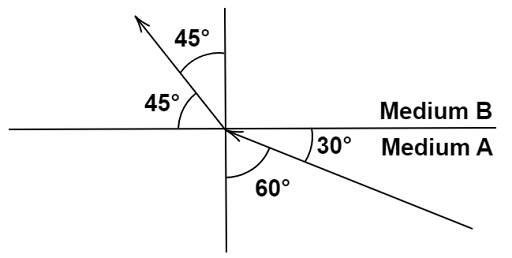
a) \[ \dfrac{{\sqrt 3 }}{{\sqrt 2 }} \]
b) \[ \dfrac{{\sqrt 2 }}{{\sqrt 3 }} \]
c) \[ \dfrac{1}{{\sqrt 2 }} \]
d) \[ \sqrt 2 \]
Ans: a) \[ \dfrac{{\sqrt 3 }}{{\sqrt 2 }} \]
Explanation: Refractive index of the medium B relative to medium A can be calculated using Snell’s law. Hence, we have, \[ {\eta _1}\sin {\theta _1} = {\eta _2}\sin {\theta _2} \].

Substituting the values, we get,
\[\dfrac{{{\eta _B}}}{{{\eta _A}}} = \dfrac{{\sin {{60}^ \circ }}}{{\sin {{45}^ \circ }}}\]
\[ \Rightarrow \dfrac{{{\eta _B}}}{{{\eta _A}}} = \dfrac{{\left( {\dfrac{{\sqrt 3 }}{2}} \right)}}{{\left( {\dfrac{1}{{\sqrt 2 }}} \right)}}\]
\[ \Rightarrow \dfrac{{{\eta _B}}}{{{\eta _A}}} = \dfrac{{\sqrt 3 }}{{\sqrt 2 }}\]
5. A light ray enters from medium A to medium B as shown in Figure 10.2. The refractive index of medium B relative to A will be
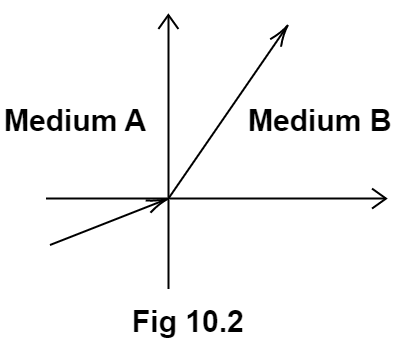
(a) greater than unity
(b) less than unity
(c) equal to unity
(d) zero
Ans: (b) less than unity
Explanation: The light ray bends away from the normal when it comes into medium B from medium A. The light ray on going from optical denser medium to optically rarer medium, always bends away from the normal. As in this case, the refracted ray is bending away from the normal. Hence, medium B is optically rarer as compared to medium A. Hence, the ratio of refractive indices of medium B to medium A will be less than unity.
6. Beams of light are incident through the holes A and B and emerge out of box through the holes C and D respectively as shown in the Figure10.3. Which of the following could be inside the box?
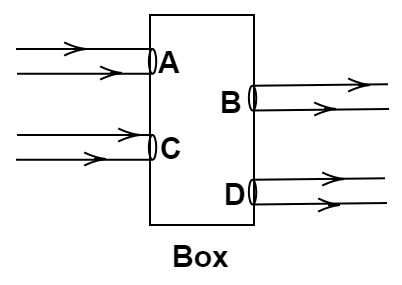
(a) A rectangular glass slab
(b) A convex lens
(c) A concave lens
(d) A prism
Ans: (a) A rectangular glass slab
Explanation: The incident rays falling perpendicularly on the surface of a rectangular glass slab are first refracted away from the normal and then re-refracted towards the normal by the same deviation. This causes lateral shift in the light ray but the direction of propagation remains the same.
7. A beam of light is incident through the holes on side A and emerges out of the holes on the other face of the box as shown in the Figure 10.4. Which of the following could be inside the box?
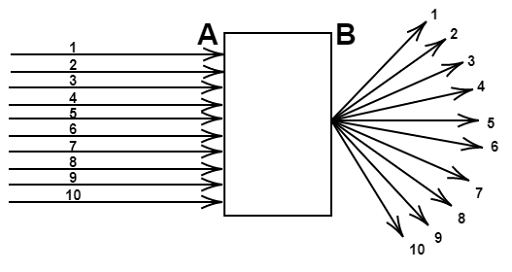
(a) Concave lens
(b) Rectangular glass slab
(c) Prism
(d) Convex lens
Ans: (a) Concave lens
Explanation: The incident rays are parallel and the rays emerging from within the box are diverging. Concave lens is also called a diverging lens. Hence, concave lenses can be there in the box.
8. Which of the following statements is true?
(a) A convex lens has \[4\] dioptre power having a focal length \[ 0.25m\]
(b) A convex lens has \[-4\] dioptre power having a focal length \[ 0.25m\]
(c) A concave lens has \[4\] dioptre power having a focal length \[ 0.25m\]
(d) A concave lens has \[-4\] dioptre power having a focal length \[ 0.25m\]
Ans: (a) A convex lens has \[4\] dioptre power having a focal length \[ 0.25m\]
Explanation: All the options have focal length as positive. A convex lens has positive focal length. Hence, this means that options (c) and (d) are incorrect. Now, Power is reciprocal of focal length in meters. Since focal length is positive, the power will also be positive. Therefore, option (a) is the correct answer.
9. Magnification produced by a rear view mirror fitted in vehicles
(a) is less than one
(b) is more than one
(c) is equal to one
(d) can be more than or less than one depending upon the position of the object in front of it
Ans: (a) is less than one
Explanation: A convex mirror is fitted in the rearview mirrors as it has a wider field of view. The images produced by the convex mirror are smaller in size than the original object. Hence, magnification produced is less than one.
10. Rays from Sun converge at a point \[15cm\] in front of a concave mirror. Where should an object be placed so that size of its image is equal to the size of the object?
(a) \[15cm\] in front of the mirror
(b) \[30cm\] in front of the mirror
(c) between \[15cm\] and \[30cm\] in front of the mirror
(d) more than \[30cm\] in front of the mirror
Ans: (b) \[30cm\] in front of the mirror
Explanation: Sun is a source of parallel beams of light. We know that all the parallel light rays converge at the focus of the mirror. So, the focal length of the concave mirror is \[15cm\]. Now, we know that if the object is kept at the center of curvature of a concave mirror, the image produced is the same in size as the size of the object. Also, the distance of the center of curvature from the pole is twice the focal length. Hence, the object should be kept \[30cm\] in front of the mirror.
11. A full-length image of a distant tall building can definitely be seen by using
(a) a concave mirror
(b) a convex mirror
(c) a plane mirror
(d) both concave as well as plane mirror
Ans: (b) a convex mirror
Explanation: Convex mirror has a greater field of vision than a concave and a plane mirror. So, it is possible to see a full-length image of a distant tall building.
12. In torches, searchlights, and headlights of vehicles the bulb is placed
(a) between the pole and the focus of the reflector
(b) very near to the focus of the reflector
(c) between the focus and center of curvature of the reflector
(d) at the center of curvature of the reflector
Ans: (b) very near to the focus of the reflector
Explanation: The reflectors are made in the shape of a concave mirror and are placed behind the searchlights and headlights of vehicles. A concave mirror produces a parallel beam of light when an object is placed near to the focus of the mirror. Therefore, the bulb is placed such that it gives a parallel beam of light.
13. The laws of reflection hold good for
(a) plane mirror only
(b) concave mirror only
(c) convex mirror only
(d) all mirrors irrespective of their shape
Ans: (d) all mirrors irrespective of their shape
The law of reflection is universal for every reflecting surface and is followed by all mirrors irrespective of their shape and nature.
14. The path of a ray of light coming from air passing through a rectangular glass slab traced by four students are shown as A, B, C, and D in Figure 10.5. Which one of them is correct?
a) A
b) B
c) C
d) D

Ans: Glass is optically denser than air. So, when light ray comes from optically rarer medium, air to optically denser medium, glass, it bends towards the normal due to refraction. Then, when a light ray coming out of glass comes into the air, it bends away from the normal due to refraction. Hence, option (b) is the correct answer.
15. You are given water, mustard oil, glycerine and kerosene. In which of these media a ray of light incident obliquely at the same angle would bend the most?
(a) Kerosene
(b) Water
(c) Mustard oil
(d) Glycerine
Ans: The bending of light ray on entering a new medium is called refraction and depends upon the refractive indices of the mediums. The light ray will bend the most in the case of medium with greatest refractive index. Glycerine has the highest refractive index. So, option (d) is the correct answer.
16. Which of the following ray diagrams is correct for the ray of light incident on a concave mirror as shown in Figure 10.6?

a) Fig A
b) Fig B
c) Fig C
d) Fig D
Ans: For a concave mirror, the incident ray parallel to the principal axis passes through focus of the mirror. Hence, option (d) is the correct answer.
17. Which of the following ray diagrams is correct for the ray of light incident on a lens shown in Fig. 10.7?
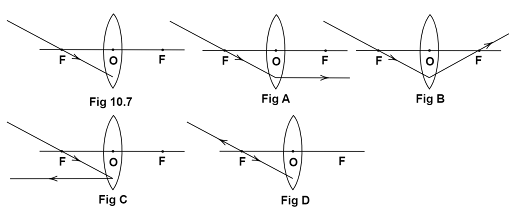
a) Fig A
b) Fig B
c) Fig C
d) Fig D
Ans: The incident rays passing through the focus of convex lens goes parallel to the principal axis after refraction. Hence, option (a) is the correct answer.
18. A child is standing in front of a magic mirror. She finds the image of her head bigger, the middle portion of her body of the same size and that of the legs smaller. The following is the order of combinations for the magic mirror from the top.
(a) Plane, convex and concave
(b) Convex, concave, and plane
(c) Concave, plane, and convex
(d) Convex, plane, and concave
Ans: (c) Concave, Plane and convex
Explanation: In case of an object kept between focus and pole, concave mirror produces a virtual, erect and enlarged image and a convex mirror produces a virtual and erect image that is smaller in size than the object. Plane mirror always produces images of the same size as the object. Hence, the combination is concave, plane and convex mirror.
19. In which of the following, the image of an object placed at infinity will be highly diminished and point sized?
(a) Concave mirror only
(b) Convex mirror only
(c) Convex lens only
(d) Concave mirror, convex mirror, concave lens and convex lens
Ans: (d) Concave mirror, convex mirror, concave lens and convex lens
Explanation: All the mentioned objects produce highly diminished and point sized images of an object that is kept at infinity.
20. Identify the device used as a spherical mirror or lens in following cases, when the image formed is virtual and erect in each case.
(a) Object is placed between device and its focus, image formed is enlarged and behind it.
Ans: Concave mirror
(b) Object is placed between the focus and device, image formed is enlarged and on the same side as that of the object.
Ans: Concave lens
(c) Object is placed between infinity and device, image formed is diminished and between focus and optical centre on the same side as that of the object.
Ans: Concave lens
(d) Object is placed between infinity and device, image formed is diminished and between pole and focus, behind it.
Ans: Convex mirror
21. Why does a light ray incident on a rectangular glass slab immersed in any medium emerges parallel to itself? Explain using a diagram.
Ans: A light ray incident on a rectangular glass slab immersed in any medium emerges parallel to itself due to the phenomenon of refraction. When a light ray enters from optically rarer medium like air to optically denser medium like glass, it bends towards the normal because of refraction of the light. When the light ray exits the glass slab and goes into air, it refracts away from the normal and emerges parallel to the incident ray.
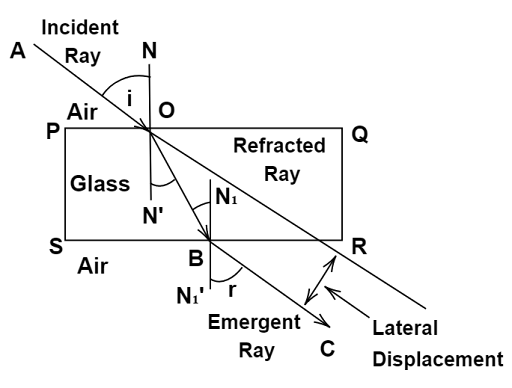
22. A pencil when dipped in water in a glass tumbler appears to be bent at the interface of air and water. Will the pencil appear to be bent to the same extent, if instead of water we use liquids like, kerosene or turpentine? Support your answer with reason.
Ans: The appearance of pencil as bent is due to the phenomenon of refraction. The degree of refraction is dependent upon the refractive indices of the media involved. Since the first medium is air in both the cases, it depends upon the refractive index of liquid in use. Therefore, the degree of bent will be different in case of liquids such as kerosene and turpentine.
23. How is the refractive index of a medium related to the speed of light? Obtain an expression for refractive index of a medium with respect to another in terms of speed of light in these two media?
Ans: The refractive index of a medium in the ratio of speed of light in vacuum to speed of light in that specific medium. So, we have, \[ \eta = \dfrac{c}{v} \], where c is the speed of light in vacuum and v is the speed of light in that medium.
Hence, refractive index of a one medium in reference to another is given by \[\dfrac{{{\eta _1}}}{{{\eta _2}}} = \dfrac{{\left( {\dfrac{c}{{{v_1}}}} \right)}}{{\left( {\dfrac{c}{{{v_2}}}} \right)}}\].
So, we get, \[\dfrac{{{\eta _1}}}{{{\eta _2}}} = \dfrac{{{v_2}}}{{{v_1}}}\].
Hence, the refractive index of the first medium in respect to the second medium is the ratio of speed of light in second medium to the speed of light in first medium.
24. Refractive index of diamond with respect to glass is 1.6 and absolute refractive index of glass is 1.5. Find out the absolute refractive index of diamond.
Ans: Relative refractive index of first medium with respect to second medium is just the ratio of refractive index of first medium to the refractive index of second medium.
So, refractive index of diamond with respect to glass \[ = \dfrac{{{\text{refractive index of diamond}}}}{{{\text{refractive index of glass}}}} = 1.6 \]
Now, we are given the refractive index of glass as \[ 1.5 \]. Substituting these values, we get,
\[ \Rightarrow \dfrac{{{\text{refractive index of diamond}}}}{{{\text{1}}{\text{.5}}}} = 1.6\]
\[ \Rightarrow {\text{refractive index of diamond}} = 1.6 \times 1.5 = 2.4 \]
Therefore, the absolute refractive index of diamond is \[ 2.4 \] .
25. A convex lens of focal length \[20\] cm can produce a magnified virtual as well as real image. Is this a correct statement? If yes, where shall the object be placed in each case for obtaining these images?
Ans: A convex lens can produce a magnified virtual as well as a real image. So, the statement is true.
For virtual and magnified images, we can place the object between focus and the optical centre of the convex lens. In this case, the image formed will be on the same side of the lens and will be larger in size than the object. So, the object should be placed at a distance of less than \[20\] centimetres from the optical centre of the lens.
For a real and magnified image, the object should be placed between focus and centre of curvature of the lens. The image is formed on the other side of the lens, and is real, inverted and magnified. So, objects should be placed between \[20\] centimetres and \[40\] centimetres from the optical centre of the lens.
26. Sudha finds out that the sharp image of the window pane of her science laboratory is formed at a distance of 15 cm from the lens. She now tries to focus the building visible to her outside the window instead of the window pane without disturbing the lens. In which direction, will she move the screen to obtain a sharp image of the building? What is the approximate focal length of this lens?
Ans: Let us assume that the window pane is between F2 and infinity from this lens and this is a convex lens. We know that when the object is between infinity and F2 , its inverted and real image is formed between 2F and 2F2 . Now, the distant building is at infinity from the lens. Its image would be formed at 2F. So, the screen needs to be moved towards the lens in order to get a sharp image. Its approximate focal length is 10cm (less than image distance in earlier cases).
27. How are power and focal length of a lens related? You are provided with two lenses of focal length 20 cm and 40 cm respectively. Which lens will you use to obtain more convergent light?
Ans: Power of a lens is defined as the reciprocal of the focal length in metres. This means that the smaller the focal length, more is the power of the lens. So, this means that out of the two lenses that we are given, the one with the focal length 20 cm will have more power as compared to the one with focal length 40 cm. The lens with higher power should be used to obtain more convergent light.
28. Under what condition in an arrangement of two plane mirrors, incident ray and reflected ray will always be parallel to each other, whatever may be angle of incidence. Show the same with the help of diagram.
Ans: When two plane mirrors are at right angles to each other, incident ray and reflected ray will always be parallel to each other, whatever may be the angle of incidence. Let us use the following figure to understand this.
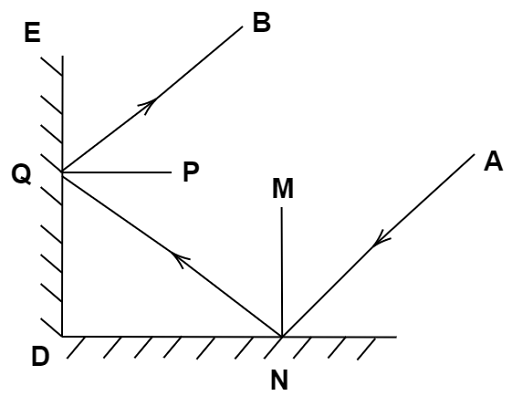
ED and DC are two plane mirrors placed at right angles. A is an incident ray on CD and MN is normal at the incidence point. So, NQ is reflected ray from N and is then incident on DE again on point Q.
Then, QB is reflected ray and PQ is normal to ED.
Now, since angle of incidence is equal to angle of reflection. So, we have,
\[ \angle ANM = \angle MNQ and \angle NQP = \angle PQB \]
Now, we also have \[ \angle MNQ + \angle QND = {90^ \circ } \] since MN is normal on CD.
Also, mirrors at right angle. So, \[ \angle QDN = {90^ \circ } \] .
In triangle QDN,
\[ \angle QND + \angle NQD = {90^ \circ } \] due to the angle sum property of triangles.
So, from above equations, we get,
\[\angle MNQ = \angle NQD\]
Hence, \[ \angle QND = \angle NQP as \angle NQP and \angle NQD \] are complementary.
Now, \[ \angle PQB and \angle PQD \] form a linear pair and are supplementary.
So, \[ \angle BQE = \angle ANM \]
Therefore, BQ is parallel to AN.
Thus, the incident ray and reflected ray will always be parallel regardless of the measure of incident angle.
29. Draw a ray diagram showing the path of rays of light when it enters with oblique incidence (i) from air into water; (ii) from water into air.
Ans: 1. When light passes from a rarer medium into a denser medium then the light slows down and the light ray bends more towards the normal shown in fig. (i).
2. The light ray bends away from the normal from a denser medium to a rarer medium shown in fig. (ii).
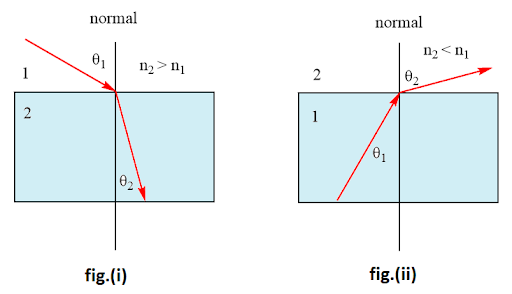
Long Answer Questions
30. Draw ray diagrams showing the image formation by a concave mirror when an object is placed
(a) between pole and focus of the mirror
(b) between focus and centre of curvature of the mirror
(c) at centre of curvature of the mirror
(d) a little beyond centre of curvature of the mirror
(e) at infinity
Ans: (a) between pole and focus of the mirror

(b) between focus and center of curvature of the mirror

(c) at center of curvature of the mirror

(d) a little beyond center of curvature of the mirror
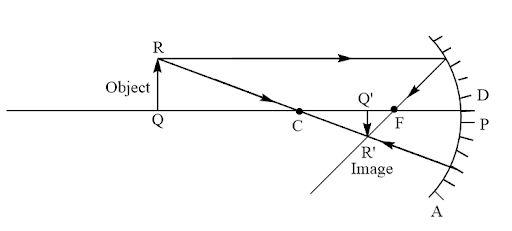
(e) at infinity
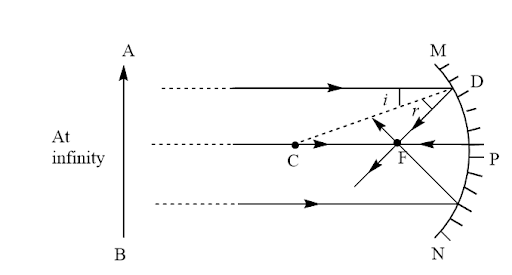
31. Draw ray diagrams showing the image formation by a convex lens when an object is placed
(a) between optical centre and focus of the lens
(b) between focus and twice the focal length of the lens
(c) at twice the focal length of the lens
(d) at infinity
(e) at the focus of the lens
Ans: (a) between optical centre and focus of the lens

(b) between focus and twice the focal length of the lens

(c) at twice the focal length of the lens

(d) at infinity
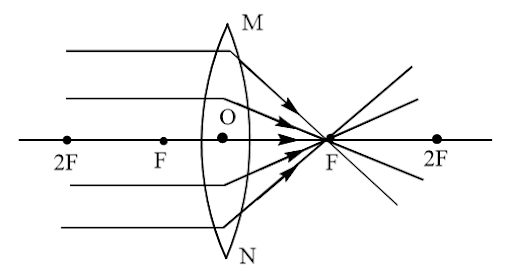
(e) at the focus of the lens
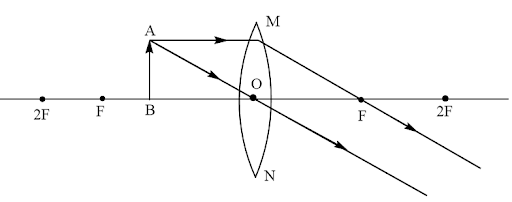
32. Write laws of refraction. Explain the same with the help of ray diagram, when a ray of light passes through a rectangular glass slab.
Ans: Refraction has following laws:
(a) At the point of incidence, the refracted ray, incident ray and normal; all lie in the same plane.
(b) For the light of a given colour and for a given pair of media, the ratio of sine of incidence to the sine of refraction is a constant. This law is also known as Snell’s Law.

(i) The glass slab is ABCD. The incident ray be EF which is incident on the point O on the air-glass interface.
(ii) The normal be NO and angle of incidence be \[ \angle EON = \angle {i_1}\].
(iii) \[N'O'\] be the normal extended towards the glass slab and angle of refraction be \[\angle N'OO = \angle {r_1}\].
(iv) From surface AB, \[OO'\] be the refracted ray from surface AB which behaves like incident ray on the surface CD.
(v) when ray EF enters the slab, it bends to become\[OO'\].
(vi) On the surface CD, \[MO' and O'M'\] are the normal.
(vii) The emergent ray is \[GH\].
(viii) At surface CD, angle of incidence is \[\angle OO'M = \angle {i_2}\].
(ix) At surface CD, angle of refraction is \[\angle MO'H = \angle {r_2}$.
(x) \[EF\], \[NO\], and \[OO'\] lie in the same plane, which is in accordance with the first law of refraction.
(xi) Emergent ray is parallel to incident ray i.e., \[ EF\parallel GH \]. This Is because the degree of bend at opposite surfaces of the glass slab is the same.
33. Draw ray diagrams showing the image formation by a concave lens when an object is placed
(a) at the focus of the lens
(b) between focus and twice the focal length of the lens
(c) beyond twice the focal length of the lens
Ans: (a) at the focus of the lens
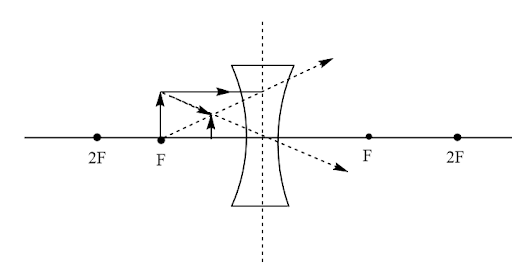
(b) between focus and twice the focal length of the lens

(c) beyond twice the focal length of the lens

34. Draw ray diagrams showing the image formation by a convex mirror when an object is placed
(a) at infinity
(b) at finite distance from the mirror
Ans: (a) at infinity

(b) at finite distance from the mirror

35. The image of a candle flame formed by a lens is obtained on a screen placed on the other side of the lens. If the image is three times the size of the flame and the distance between lens and image is 80 cm, at what distance should the candle be placed from the lens? What is the nature of the image at a distance of 80 cm and the lens?
Ans: It is given that; magnification is three times and image distance is \[ v = 80\;cm \]
Magnification \[ = \dfrac{v}{u} \]
\[ \Rightarrow 3 = \dfrac{{80\;cm}}{u} \]
\[ \Rightarrow u = \dfrac{{80\,cm}}{3} \]
As per sign convention the object distance is taken as negative;
\[ \Rightarrow u = - \dfrac{{80\;cm}}{3} \]
Nature of image: As image is formed on the other side of lens hence it is real image and inverted image.
Nature of lens: As the image is enlarged by convex lens not by concave lens, so it is a convex lens.
36. Size of image of an object by a mirror having a focal length of 20 cm is observed to be reduced to \[ \dfrac{1}{3}rd \] of its size. At what distance the object has been placed from the mirror? What is the nature of the image and the mirror?
Ans: The image distance is \[ \dfrac{1}{3}rd \] of object distance as the image size is \[ \dfrac{1}{3} \] of object size because
\[ \dfrac{{h'}}{h} = \dfrac{v}{u} \]
We can calculate object distance and image distance by using the mirror formula,
\[ \dfrac{1}{v} + \dfrac{1}{u} = \dfrac{1}{f} \]
\[ \Rightarrow \dfrac{3}{u} - \dfrac{1}{u} = - \dfrac{1}{{20}} \]
\[ \Rightarrow \dfrac{{3 - 1}}{u} = - \dfrac{1}{{20}} \]
\[ \Rightarrow u = - 40\,cm \]
We can find image distance by using:
\[ \dfrac{1}{v} + \dfrac{1}{u} = \dfrac{1}{f} \]
\[ \Rightarrow \dfrac{1}{v} - \dfrac{1}{{40}} = - \dfrac{1}{{20}} \]
\[ \Rightarrow \dfrac{1}{v} = - \dfrac{1}{{20}} + \dfrac{1}{{40}} \]
\[ \Rightarrow \dfrac{1}{v} = \dfrac{{ - 2 + 1}}{{40}} \]
\[ \dfrac{1}{v} = - \dfrac{1}{{40}} \]
But our assumption does not match with the value of image distance. This means that this mirror is a convex mirror, not a concave mirror. Thus, assuming that it is a convex mirror so,
\[ \dfrac{1}{v} + \dfrac{1}{u} = \dfrac{1}{f} \]
\[ \Rightarrow \dfrac{1}{v} - \dfrac{1}{{40}} = - \dfrac{1}{{20}} \]
\[ \dfrac{1}{v} = - \dfrac{1}{{20}} + \dfrac{1}{{40}} \]
\[ \dfrac{1}{v} = \dfrac{3}{{40}} \]
\[ v = \dfrac{{40}}{3}cm \]
Nature of mirror: convex mirror
Nature of image: it is smaller than an object, erect and virtual.
37. Define power of a lens. What is its unit? One student uses a lens of focal length 50 cm and another of –50 cm. What is the nature of the lens and its power used by each of them?
Ans: The ability of the lens to converge or diverge the ray of light falling on it is termed as power of a lens. We can also say that power is reciprocal of focal length of the lens. It is denoted by \[D\].
Here the focal length taken by the first student is positive thus it is a convex lens. And the second student is a concave lens.
\[ p = \dfrac{1}{f} \]
\[ = \dfrac{1}{{0.5}} \]
\[ = 2 \]
So, the power of the lens (of first student) \[ = + 2 \]
And the power of the lens (of second student) \[ = - 2\]
38. A student-focussed the image of a candle flame on a white screen using a convex lens. He noted down the position of the candle screen and the lens as under Position of candle = 12.0 cm Position of convex lens = 50.0 cm Position of the screen = 88.0 cm
(i) What is the focal length of the convex lens?
(ii) Where will the image be formed if he shifts the candle towards the lens at a position of 31.0 cm?
(iii) What will be the nature of the image formed if he further shifts the candle towards the lens?
(iv) Draw a ray diagram to show the formation of the image in case (iii) as said above.
Ans: (i) \[ u = 50 - 12 \]
\[ = 38\;cm \]
The image distance \[ v = 88 - 50 \]
\[ = 38\,cm \]
Thus, the focal length can be calculated using the lens formula;
\[ \dfrac{1}{v} - \dfrac{1}{u} = \dfrac{1}{f} \]
\[ \Rightarrow \dfrac{1}{{38}} + \dfrac{1}{{38}} = \dfrac{1}{f} \]
\[ \Rightarrow f = 19\,cm \]
(ii) in this case, object distance = focal length
\[ u = 50 - 31 \]
\[ = 19\,cm \]
This means that the image which is formed is at infinity.
(iii) when he shifts the candle further towards the lens, then the object comes between \[ F \] and \[ O \]. In this case, the image which is formed is virtual, enlarged, erect and is formed on the same side of the lens.
(iv)
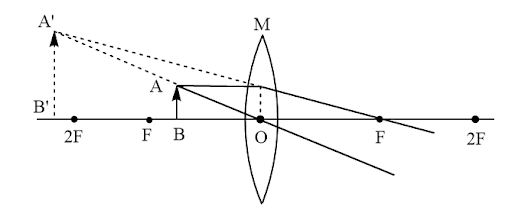
Vedantu’s Class 10 Science NCERT Exemplar for chapter 10- Light Reflection and Refraction - Free PDF Download
NCERT Exemplar Solutions for Class 10 Science Chapter 10 Light Reflection and Refraction will improve your preparation level by providing a pdf that contains questions and answers on the topic "Light Reflection and Refraction". In this Chapter 10, students will get to know about the phenomena of reflection and the definition of refraction of light. At the same time, they will also know about the basic concepts that are related to the chapter. They will also understand the complete phenomenon of the reflection of light by spherical mirrors and refraction of light and other concepts like the mirror formula, refractive index, lens formula, and so on. These exemplars will offer quick learning so that every student will be able to get a clear idea on all the concepts and topics given in Chapter 10.
About Vedantu’s NCERT Solutions
This Free PDF is solved by Vedantu expert Science teachers. All Chapter 10 - “Light reflection and refraction” Exercise questions with solutions are to help students to recall the complete syllabus and get more marks in their examinations.
When students reach Class 10, subjects such as science and mathematics can be a bit difficult to study in a proper way. In such cases, taking the help of NCERT solutions for Class 10 science can help students understand the concepts which include difficult topics. Vedantu has a collection of pdf solutions for NCERT Class 10 science chapters which help the students get involved in the chapters and get the knowledge of the concepts that are required.
FAQs on NCERT Exemplar for Class 10 Science Chapter 10 - Light Reflection and Refraction (Book Solutions)
Vedantu’s Chapter 10 of NCERT Exemplar Solutions for Class 10 Science covers some topics. They are listed below:
Reflection of Light
Spherical Mirrors
Image Formation by Spherical Mirrors
Representation of Images Formed By Spherical Mirrors Using Ray Diagrams Ex
Sign Convention for Reflection by Spherical Mirrors
Mirror Formula and Magnification
Refraction of Light
Refraction through a Rectangular Glass Slab
The Refractive Index
Refraction by Spherical Lenses
Image Formation by Lenses
Image Formation in Lenses Using Ray Diagrams
Sign Convention for Spherical Lenses
Lens Formula and Magnification
Power of a Lens.








































